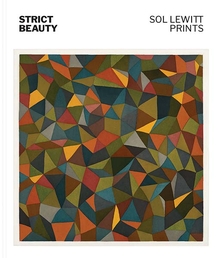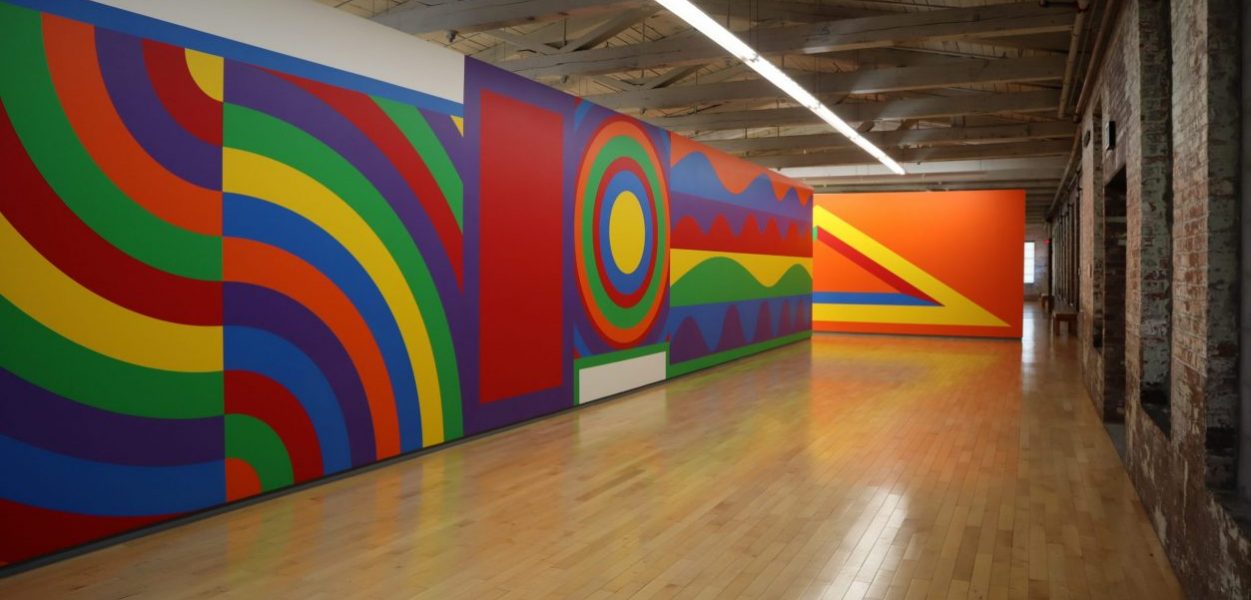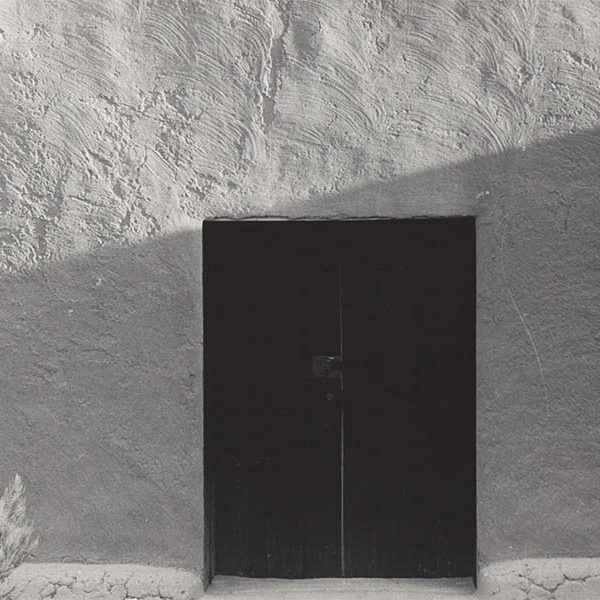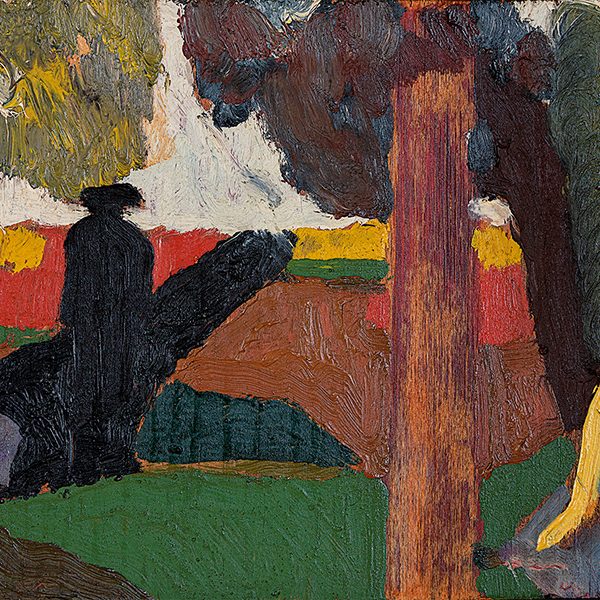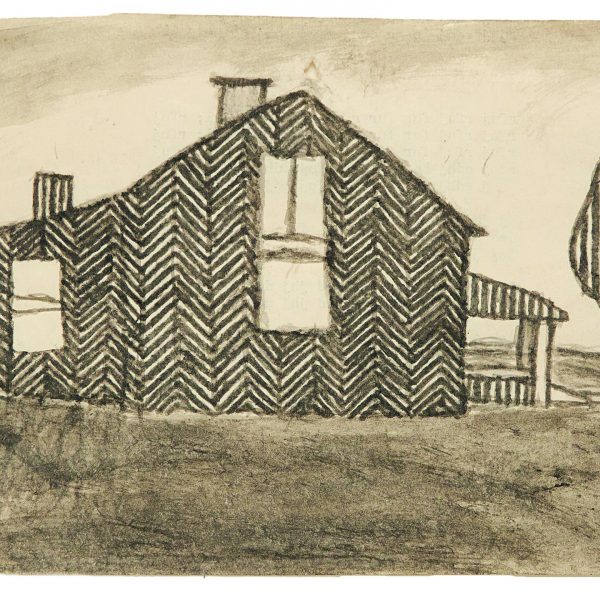The Intimate Art of Sol LeWitt
David S. Areford—
Sol LeWitt. For the dedicated or even occasional museum visitor, the artist’s name conjures up expansive and colorful murals (his “wall drawings”) and equally commanding, large-scale cubic sculptures (his “structures”). Often installed in grand public interior or exterior settings, these artworks collaborate with the architectural and spatial dynamics of their immediate contexts. As a result, they have a magnetic presence that commands the simultaneous attention of large audiences of viewers.
But there is another less celebrated and more intimate dimension to LeWitt’s art, found in the hundreds of prints—silkscreens, lithographs, etchings, aquatints, linocuts, and woodcuts—he produced from 1970 until his death in 2007. Intrinsically small-scale, these works demand the attention of one viewer at a time, a viewer willing to move in close, linger, and engage with the artist’s abstract vocabulary of of lines, bands, brushstrokes, and geometric figures.
Small Line Etchings, a set of four prints created in 2005 and published by Pace Editions, is a perfect demonstration of this more personal LeWittian mode. Consisting of two pairs, the set was produced from 6 x 5-inch copper plates printed in the middle of 12.5 x 12.5-inch sheets of paper. The first pair presents a seemingly continuous, meandering line, clearly related to the “loopy doopy” and “loops and curves” wall drawings, prints, and paintings on paper initiated in 1998.
Sol LeWitt, Small Line Etchings, 2005. Etching and aquatint, set of four, plate: 6 x 5 in. (15.2 x 12.7 cm), sheet: 12.5 x 12.5 in. (31.8 x 31.8 cm). © Estate of Sol LeWitt 2021, Photo courtesy of Pace Prints
The second pair’s lines are relatively short, “not straight,” generally “not touching,” and distributed evenly: all visual characteristics that originated in wall drawings and prints dating to 1970.
Sol LeWitt, Small Line Etchings, 2005. Etching and aquatint, set of four, plate: 6 x 5 in. (15.2 x 12.7 cm), sheet: 12.5 x 12.5 in. (31.8 x 31.8 cm). © Estate of Sol LeWitt 2021, Photo courtesy of Pace Prints
Reflecting LeWitt’s fondness for variations on a theme, each pair depends on only one plate of lines printed, respectively, in black ink on white (the white of the paper) and white ink on black (the black of an aquatint plate).
The year 2005 marked a decline in LeWitt’s health, specifically the spreading of a cancer first diagnosed three years earlier. Thus he was unable to travel to Watanabe Studio, the Brooklyn workshop where most of his prints were made at the time. Instead, copper plates covered with a hard layer of wax were sent to the artist in Chester, Connecticut. There, adjacent to his house, he worked daily in his studio, a bright and open space with a gridded wall of windows over twenty-feet high and framing a view of tall trees. Wielding a sharp etching needle, the artist likely drew on the plates while sitting at a corner drafting table and listening to classical music.
Counter to the assumed impersonal nature of LeWitt’s conceptual art based on preconceived ideas, procedures, and usually carried out by assistants, the pleasure of viewing these etchings involves imagining the artist creating them. They are focused demonstrations of his typical approach—carried out in one sitting, a mix of control and chance as LeWitt allowed his abstract language to do its own thing as it filled up each plate.
When examining the first pair, there is an intimacy in following the trajectory of spiraling lines, locating their beginnings and ends, noting links and breaks along the way, and reaching the multiple centers.
Sol LeWitt, Small Line Etchings, 2005. Etching and aquatint, set of four, plate: 6 x 5 in. (15.2 x 12.7 cm), sheet: 12.5 x 12.5 in. (31.8 x 31.8 cm). © Estate of Sol LeWitt 2021, Photo courtesy of Pace Prints
The entire image is decidedly biomorphic, like a cross-section of something organic and layered. On the other hand, the concentric clusters of lines also suggest a cache of ancient scrolls rolled up and squeezed together in a box, just their edges visible, their contents hidden.
The textual analogy is helpful when looking at the second pair. Although distinctly maze-like overall, the mainly short, squiggly marks have a calligraphic quality and can be perceived as units or groups.
Sol LeWitt, Small Line Etchings, 2005. Etching and aquatint, set of four, plate: 6 x 5 in. (15.2 x 12.7 cm), sheet: 12.5 x 12.5 in. (31.8 x 31.8 cm). © Estate of Sol LeWitt 2021, Photo courtesy of Pace Prints
Indeed, the scale of the image area is not unlike a page in a book. However, while scanning these lines is comparable to reading, the “text” quickly morphs into a series of fluctuating images. One cannot help but see visual connections as the crooked lines of varied length and direction begin to delineate the contours of objects and bodies with little heads, arms, and legs. In the white-on-black version, this effect is heightened as the negative space (the space between the lines) asserts more presence.
This accidental figuration is a danger of some forms of abstraction and LeWitt typically tried to avoid it. Of course, like a Rorschach inkblot, what is seen is not the result of the artist’s intentions but the viewer’s psychology, imagination, and degree of visual inventiveness.
Officially, LeWitt’s lines were just lines, as he wrote in 1970: “A line only stands for itself. It doesn’t describe anything but a line.” Yet, in Small Line Etchings, the lines and their abstract configurations are designed to captivate, to invite us in, each pair of prints framing a miniature world—experienced by day and night—in which we can wander and get lost.
David S. Areford is associate professor and department chair of art at the University of Massachusetts Boston. His most recent books are Strict Beauty: Sol LeWitt Prints and Locating Sol LeWitt.
Further Reading:
